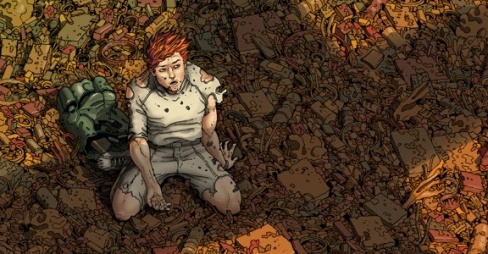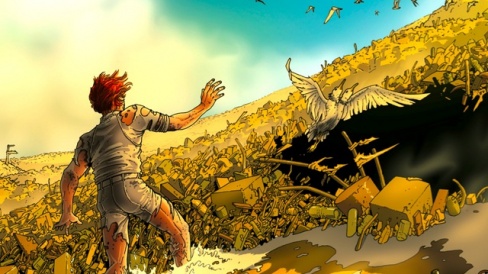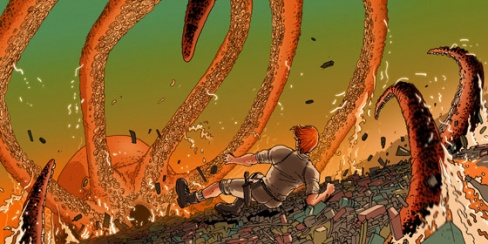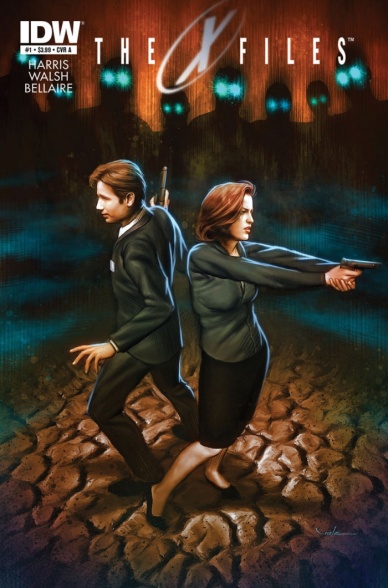It seems like every year there is a book that sneaks up on you and blows you away. One of the books that has done that to me over the past six months is Image Comics title “Great Pacific,” a book from writer Joe Harris and artist Martin Morazzo. I had heard very little of it before it arrived, but when it came to the Wednesday of its release, I walked the racks at my local comic book shop and the beautiful cover from Morazzo convinced me that it needed to come home with me.
It was a great decision, as this book has been a knock out ever since. Morazzo is a big reason why, with beautiful and inventive art that excels at storyteller, but I love everything about the concept and execution from Harris. I reached out to Harris to chat about this book, to see where it came from and where it’s going, and even chatted with him a little bit about his upcoming work on X-Files Season 10. Thanks to Joe for chatting with me, and do yourself a favor and check this book out sooner rather than later.

Obviously it’s a bit of a disgusting monstrosity of modern culture, but the Great Pacific Garbage Patch as the seed of a story and a trust fund kid revolution wasn’t something I ever expected to see. Where did the idea behind Great Pacific come from?
Joe Harris: Well, the reality of what we’re doing, and have done, to the oceans is definitely a driving influence here. I can tell you that every time the so-called “Great Pacific Garbage Patch” pops up in the news I get twenty or so emails from folks who associate me, and Great Pacific, with it and who want to make sure I saw the latest Yahoo! news item (I did, thanks!). So that’s the obvious, initial driver of this series and my own sort of genesis of it all.
Aside from that, it’s the product of my love for both science fiction and survival movies such as The Naked Prey, which was written, directed and starred in by British actor Cornel Wilde. Also, I suppose, this fascination I have with industrialists and the oil industry.
Before we get into the depths, Martin Morazzo is an absolutely phenomenal artist, and someone whose work I had never experienced before this book. How did you find him, and what made him such a perfect fit for this title?
JH: You know, I’d wanted to work with an artist who felt “international” and worldly and who wasn’t necessarily a product of lots of love for Marvel and DC superheroes. Not that there’s anything wrong with that, obviously. But I lived with the concepts and details of Great Pacific, on my own, for a while and, before I found Martin, I had this ludicrous notion of wanting Moebius to draw it. Or, you know, Geoff Darrow (if I had to slum it a bit). In all seriousness though, Martin just fit the bill I was looking for.
I discovered his work while checking out strips on DC’s now defunct Zuda site. He’d illustrated a series called Absolute Magnitude and I knew, after seeing just a couple of pages, that he was my guy. I reached out to him, pitched myself and my story to him, told him what I’d done and what I believed this series could be, and I promised to work hard to help us both realize success on this book. He responded with a series of designs and illustrations that just took the sort of world I’d been envisioning to an entirely new level. I really felt the plastic and garbage ground our characters walked over. I got both the epic sci-fi adventure feel, plus the “worldly” character to the artwork that I’d hoped for.
Of all the things I’m both proud of and enjoy about creating Great Pacific, that people are exposed to the beautiful illustrative talent of Martin Morazzo as a result, ranks right near the top, for me.
How did you and Martin work together to develop the look and feel of the Patch? How much research did you put in to developing it?
Continued belowJH: I’d done a lot of research and conceptual work on my own before Martin and I met. But, like I said earlier, he really just blew me away with his first batch of designs. I’d send him descriptions of these concepts I’d had, from Maasai Warriors to downed Soyuz space capsules to mutated marine life and pirate raiders, and he just riffed off my direction so well. It’s been a wonderfully satisfying collaboration.
Chas Worthington is a very fascinating lead, in that he’s in many ways very selfish, overly confident and, perhaps worst of all, kind of a bad friend to his seemingly only friend Alex, yet you can’t help but like the guy and want to root for him. What was the genesis for him as a character, and what makes him such a good lead for this book?
It was really important, for me, going in that our protagonist not be some crusading environmental would-be savior. Not in the most obvious ways, anyway. I’m proud that this book doesn’t preach very much, and I often joke that Chas Worthington isn’t on some quest to get the world to start recycling. You point out a lot of his foibles, and I think they’re mostly fair. I’d also suggest that you probably like Chas because he’s sincere, and without malice, and driven. He’s no phony about what he’s trying to do. And, though I suspect he might piss some people off along the way—both within his supporting cast, and among our readership—I’d like to believe he’s going to keep you coming back because he’s always got a higher plan, even when he’s in over his head. And he’s certainly over his head here.
Chas is someone who sees problems with the way the world is run today, and he does what he can to fix it the way he knows how. Is there a part of Chas’ perspective that comes from the way you see things, or is this simply a situation where it’s a writer writing a character?
JH: Anyone who follows me online finds out pretty quick what my values, politics and pet causes are. I’m not very shy about speaking my mind or stacking up a few soapboxes, even if I don’t expect anyone to really give a shit what I have to say. If they do, awesome. But, you know, I don’t expect anything to come of my venting.
Chas is his own breed though. I don’t think he has any politics, and serves no philosophy save his own. Sometimes I think he’s this Ayn Rand-ian breed of libertarian… but that’s too easy. I don’t think he’d advocate for anyone to do the things he’s attempting. He’s full of himself, and believes he’s right, and we’ll see the fallout from that position, along with, I do hope, what comes next.

New Texas. First off, that is completely perfect for Chas a character, but it’s also hilarious and very fitting the mentality of some from that state. Second off, where did that come from? Was it a natural extension of Chas as a character, or did that come up as a thought not really connected to him?
JH: It was both an idea that welled up, organically, as well as due to some calculation. When you first start researching the so-called “Great Pacific Garbage Patch,” one of the first little sound bites of information that jumps out at you—or, me, in this case—is that scientists estimate this massive mess of garbage and plastic soup swirling around the North Pacific Gyre to be about twice the size of Texas.
After letting that horrifying factoid sink in, all the little imaginary lines of connectivity began to form this web across my brain. We’ve got Texas, which is a “tag” or “keyword” when discussing the Garbage Patch, and it’s also the home of the American petroleum industry. It all kind of just lit up for me.
When dealing with such big environmental issues, how difficult is it to toe the line between effective storytelling and preachy?
Continued belowJH: I desperately don’t want this book to be preachy. The environmental message is inherent and doesn’t need me to be that direct, I think. It would also make for a rather boring character, and I both wanted and see Chas to be very complex.
I think he’s going to do just enough to piss people off to make the toeing of said line, as you put it, rather easy, to be honest.

Between, Yalafath and Little Chief, it’s hard for me to decide who my favorite character is, but I love them both even if one is a giant squid who may have a crush on Chas. They also both represent a world that Chas thought he could walk into and fix and own at the same time, yet he’s found himself playing from behind in that regard. How extensive have you gotten in developing the world of this book, and do you have a plan for how long and far you want to take this title?
JH: Oh, we’re fleshing out our second story arc, “Nation Building,” which launched in issue #7 in June and, I can tell you, the world is going to expand. We’ll see New Texas grow into a frontier town, almost like our aesthetic transposed over a Deadwood-type setting in which folks are immigrating to this newly, aspiring country in order to work on the vast terraforming operations launched via the HERO technology in order to transform the Pack a bit and make it more livable.
One of my favorite science fiction novels is Walter Miller’s, A Canticle For Leibowitz, in which we watch a post-apocalyptic, neo-primitive society begin to rediscover the lost technology and accomplishments man lost in some unspecified nuclear deluge. Mankind, over millennia, enters a new age of enlightenment and rediscovery. We see cities grow again and mankind achieves new heights… before the same old frailties and failures threaten the world with new annihilation. And I think that’s where I’d like to take the world of New Texas. I want to build it into a society, an aspiring utopia, all the while threatening it with the worse elements of our human character.
Honestly, I’d like to write Great Pacific for at least a few years. I do have an ending in mind, but I also have a lot of ideas and twists that could, potentially, draw this out a bit.
The HERO technology is the backbone of Chas’ plan, and it’s a wonderful idea. Where did the idea for that technology come from? Is it purely speculative, or is it based on a real technology being developed?
JH: It’s pretty speculative, but it does spring from the ever-evolving need to build a better mousetrap with regard to cleaning up ocean oil spills. Watching the BP disaster in the Gulf of Mexico a few years back, I was struck by how terrible and antiquated the methods for sopping up spills seemed. Forget about the disaster on the seafloor for a second… I just mean the surface spills. We were watching workers lay boom in these pathetic attempts to contain these growing, horrific amounts of oil, all the while we were seeing pictures of animals coated and dying, marshland contaminated, and on and on and on.
HERO, as it is described in our book, would be a holy grail. The idea of remediating oil, let alone plastics, down to something less odious and biodegradable would be a game-changer, I would think.

You also have X-Files Season 10 coming up. What appealed to you about that project (besides obviously working with the tremendously talented duo of Michael Walsh and Jordie Bellaire), and what level of freedom do you have in telling your own X-Files stories?
JH: What appealed to me about working on The X-Files is that I’m a huge fan, and have been going back to the early 1990s. It’s one of the absolute greatest science-fiction television shows in history with a cast as memorable and beloved as anything Star Trek, Dr. Who or any other upper-teir franchises can boast, along with a concept that’s often imitated but seldom matched. And, hey — working with Michael and Jordie isn’t a bad score either!
Continued belowI’m actually getting a lot of freedom, which is incredibly gratifying, as well as a little scary to be honest with you. IDW approached me and I feverishly churned out a pitch for an opening story arc that reestablished the concept, Mulder and Scully, as well as the dizzying, aliens/conspiracy mythology commonly referred to as the “mytharc” by the faithful. I also peppered in plenty of one-off “Monster of the Week” story ideas, including some direct sequels to classic episodes I hope fans will really respond to, along with plans to take this thing into a second and third year, each time building on what we established before, as well as pulling the rug out from what you thought you knew about Mulder, Scully, their role at the FBI, the looming alien colonization and the conspiracy both within, and outside, our government to help bring it about.
IDW and FOX loved what I pitched, but the ultimate validation came when Chris Carter agreed to come onboard in an “Executive Producer” role. He was so complementary and supportive and, I say again, it’s so awesome it all scares me to death sometimes!
Besides more Great Pacific and the upcoming X-Files, do you have anything else on your plate that’s coming up?
JH: Well, I’ve got a new graphic novel called Wars In Toyland coming out in July from Oni Press with artwork by my old friend, Adam Pollina. It’s a dark fantasy, and a gorgeous book.



